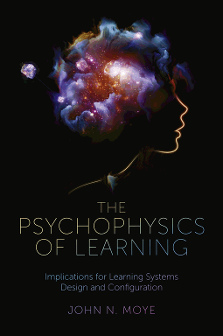The Psychophysics of Learning

Implications for Learning Systems Design and Configuration
Synopsis
Table of contents
(12 chapters)Abstract
Chapter 1 introduces the science of psychophysics to establish the initial condition and expectations for the work. The chapter begins with an overview of psychophysics, its limitations, and its measurement approaches, which are equivalent to the sensation processes. The science of psychophysics is delineated and differentiated from similar fields of study to discriminate it as a science, which is equivalent to the processes of perception. Finally, this information is compiled into a table, which integrates the information into a cognitive model of the nested systems to be discussed (cognition).
In a psychophysical learning system, this chapter establishes the definition of psychophysics, removes irrelevant information from the conceptual framework, and relates the information to future discussions (immediacy), which creates a flow within the learning process.
Abstract
Chapter 2 discusses the relevance and potential benefits of the text to the realities of learning system design and configuration. The chapter is presented as an argument in support of the relevance of the work and its perspective on learning. It presents a continuous flow (implicate order), which reflects the structure of the discipline (argumentation). The three-part model of collection, discrimination, and integration into practice is configured into a continuous flow in the argument. This chapter creates interest and expectations in the subsequent discussions, which are reexamined in Chapter 9 to connect expectations with outcomes for the work.
Abstract
Chapter 3 examines the attributes of an external stimulus, which the brain collects and models to construct a sensation. An important aspect of this process is the sensory system's filtering capacity, which removes extraneous and irrelevant information from the modeled information. The response mechanisms of all five senses are discussed to establish the practice of viewing the discipline (psychophysics) from multiple perspectives (senses). The differences in multiple perspectives on the same data is compiled into a model of the attributes to which the brain attends to engage with a sensation.
Abstract
Chapter 4 presents the research into the attributes of a stimulus, which the brain uses to construct a perception of the external stimulus. The processes used in all five senses are examined and compiled into a collective model of the processes the perceptual system uses to discriminate and understand an external stimulus. While there are many commonalities across the senses, the structure of the discipline (energy) each system processes yields unique insights into the processes of the total system.
Abstract
Chapter 5 changes focus from the external stimulus to the internal sensemaking by integrating and comparing new learning with the prior learning of the individual, which is the process of sensory cognition. These processes are identified and compiled into a model of the processes the brain uses to construct a cognition from the information, including both individual and collective learning. This results in the internalization of a new individual cognition constructed from the integration of the new information with prior information.
Abstract
Chapter 6 synthesizes the psychophysics of sensation into a plausible model for the design and configuration of the learning engagement dimension of a learning system. In sensation, the task is to collect and review stochastic information collected from an external stimulus. In learning systems design, the task is the opposite: to design learning objects and activities that communicate the intended learning to the learner effectively and efficiently. The sensation systems focus their attention on the structure of the stimulus. Likewise, a psychophysical learning system emphasizes the interconnections within categories of content to configure the learning experiences. The curriculum embeds this information into a learning plan.
Abstract
Chapter 7 synthesizes the perception research into plausible design and configuration strategies for the learning experience dimension of a psychophysical learning system. The processes used in all five senses to reduce information into a perception are again used to create learning activities and processes, which facilitate the learning and discriminate meaning from the learning objects and activities. This process attends to the interactions across the categories of content to determine the critical components of the discipline to include in the learning experience. Once again, the focus of the psychophysical learning experience is placed on the structure of the (external) discipline, which is used to configure the learning experiences.
Abstract
Chapter 8 synthesizes the research findings from the processes of sensory cognition into the design and configuration of the learning environment. The focus of cognition changes perspective and focus from the attributes of an external stimulus to the internal processes of integration with prior learning and internalization into a new cognition of the individual, which is labeled as the individual's learning ecology. These processes provide a plausible model for the design of the learning environment dimension, which internalizes the learning into transformational and ultimately lifelong learning. The processes of sensory cognition provide a viable and practical model to engineer learning cognition in the same way the brain does with sensory cognition. Like sensory cognition, learning cognition is the result of the structure of the learning environment.
Abstract
Chapter 9 closes the loop with Chapter 2 to demonstrate the methods and techniques that can achieve the goals and objectives presented in Chapter 2. The attributes of the total system are summarized and supported with research that has examined its effectiveness in real-world applications. The attributes of the learning engagement, experience, and environment are discussed and supported with available practical and action research. As in the construction of cognition, this chapter is constructed in a matrixed model where the interactions across categories are explicit from multiple perspectives, which reveals the interactions across the categories of content.

- DOI
- 10.1108/9781801171137
- Publication date
- 2021-06-22
-
- ISBN
- 978-1-80117-114-4
- eISBN
- 978-1-80117-113-7